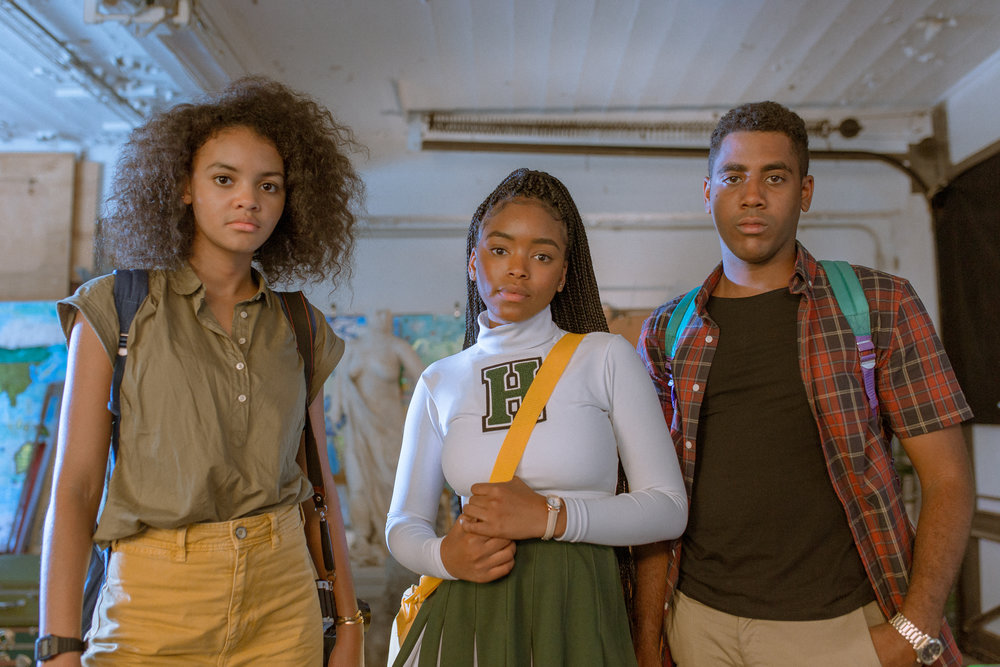Despite being one of the few things left to do, watching movies during the coronavirus lockdown is a strange experience. What was innocuous in the olden days takes on brand new connotations: characters standing in a group of five or more? Horror movie. Characters touching? X-rated. We can’t let our children observe the customs that killed the world. But enough with the apocalyptic outlook—there’s a new movie to distract us! Selah and the Spades, a Sundance 2019 hit, is dropping on Amazon Prime for your home viewing pleasure. And speaking of customs that used to make sense but don’t anymore: it’s about the social dynamics of high school.
Not exactly the kind you remember, though. On the surface, Haldwell looks like any wealthy private school, but beneath the prestigious façade there’s an organized, underground enterprise. The student body has divided itself into five factions: there’s the Sea, who will do anyone’s homework for cash; the Skins, who organize gambling rackets around the school’s sports; the Prefects, who keep the school administration looking the other way; the Bobbys, who throw the parties; and the Spades, who deal the drugs. The leader of each faction holds great power over the student body, but the most feared and respected of them all is Selah, who rules the Spades with an iron will and a detailed ledger.
The interplay between the factions is pretty immediately involving. Writer/director Tayarisha Poe, making her directorial debut here, frames and writes faction meetings like they were a tradition passed down from antiquity. Faction leaders debate while their second-in-commands take minutes; coded language is traded, hinting at formative, unspoken events in the factions’ pasts; Poe fastidiously alternates between low-angle, high-angle, and close-up shots to define the spaces in which—and the people in whom—power resides. It’s transparent that no conversation is just a conversation to Poe, and she makes a case for the visual canvass being the optimal place to express that belief.
Her experiments with the form fill out every incident on the Haldwell grounds, transforming archetypal high school settings into cinematic splatter paint. An early scene in the gym uses shot and editing patterns that break spatiotemporal flow—two characters talking face to face are made to look as if they’re facing the same direction, for example—and scenes in dorm rooms feature an ambient, almost amelodic score, freezing moments in time like a beat on repeat. The resulting aesthetic is always grounded, yet always a little fantastical, like magical realism without actual magic. The realistic and the mystical intertwine so fluidly that Haldwell’s goings-on function both metaphorically and literally: symbol and story come together as one without forsaking a sensible plot or deeper meaning. Selah and the Spades can be approached as a twist on the high school genre, or as a thesis on marginalized power in hegemonic spaces—it’s rewarding either way.
There are some first-time feature bugs like mistimed audio cues and instances of amateurish acting, but they’re not enough to pull you out of Poe’s engrossing world. The production design plays a large part in that: sets are viscerally textural, like you could reach out and feel their contours. An inky-black theater adorned with rivulets of blood-red yarn, a senior-pranked staircase made untraversable by ritualistically arranged, colorful cups—the movie’s a bouquet of high school paraphernalia.
The third act, though, displaces itself from that environment. It still unfolds on high school grounds, but unlike the rest of the movie, it could realistically happen elsewhere, which robs the movie of its sheer particularity and leaves some school-centric subplots out to dry. The ending suggests that the story wasn’t as firmly set in Poe’s vision as the tone and look were. It hurts, but mostly because of the promise that Poe had on display previously. If her next project is a step up, it could touch the sky.
★★★½ (3.5/5)




